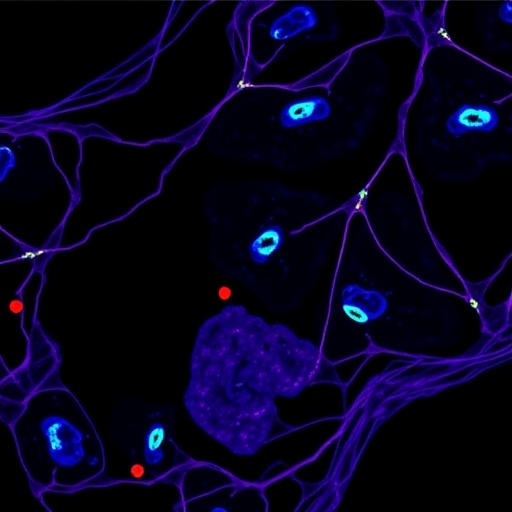In a groundbreaking discovery that could dramatically alter the therapeutic landscape for rare soft tissue tumors, researchers have uncovered pivotal genetic mutations in unclassified pericytic tumors, revealing new avenues for targeted treatment. These tumors, long enigmatic and diagnostically challenging, have now been linked to actionable BRAF mutations, heralding a new era where precision medicine can play a vital role in patient management.
Pericytic tumors, characterized by their hemangiopericytoma (HPC)-like architectural patterns, have historically defied clear genetic classification. Despite their clinical significance, the molecular underpinnings governing their behavior and progression remained elusive. This mystery has hindered clinicians in choosing tailored treatment strategies, often relegating patients to broad-spectrum therapies with limited efficacy. The latest research leverages advanced genomic techniques to illuminate the genetic fabric of these neoplasms, offering crucial diagnostic and therapeutic insights.
Central to this research was a unique clinical case involving a newborn female patient suffering from a large congenital sublingual pericytic tumor. Her disease course was marked by tumor recurrence following surgical resection and an alarming resistance to conventional chemotherapy regimens. Employing the Ion AmpliSeq Comprehensive Cancer Panel, a high-throughput sequencing technology specialized for oncogenic landscapes, the cross-disciplinary team pinpointed a somatic BRAF V600D mutation within the tumor. This mutation, distinct yet functionally analogous to the more common V600E variant, is known to drive tumorigenesis through aberrant activation of the MAPK/ERK signaling cascade.
Recognizing the therapeutic potential of this finding, clinicians initiated treatment with dabrafenib, a selective BRAF inhibitor (BRAFi) previously approved for managing melanomas harboring BRAF mutations. Remarkably, the infant exhibited dramatic tumor regression and clinical improvement, underscoring the mutation’s role as an oncogenic driver and validating targeted therapy’s efficacy beyond its conventional indications. This clinical triumph not only transformed the patient’s prognosis but also provided a compelling proof-of-concept for broader application.
To determine the prevalence of BRAF mutations among pericytic neoplasms, researchers expanded their molecular inquiry to include 15 additional HPC samples. Using Sanger sequencing, a gold-standard genomic validation method, the team uncovered BRAF V600E mutations in 40% of these tumors, highlighting a previously underappreciated genetic vulnerability. These findings challenge the historical categorization of pericytic tumors as genetically inert and open the door for revisiting diagnostic criteria with integrated molecular diagnostics.
The significance of identifying BRAF mutations within this rare tumor subset cannot be overstated. BRAF, a serine/threonine-protein kinase, orchestrates critical cellular proliferation and survival pathways. Its mutation, especially at codon 600, constitutively activates downstream signaling, fostering oncogenesis. Targeted BRAF inhibition disrupts this aberrant pathway, inducing tumor cell apoptosis and growth arrest. Prior successes in malignancies such as melanoma and non-small cell lung cancer have cemented the therapeutic paradigm, but pericytic tumors represent uncharted territory.
This research epitomizes the fusion of technological innovation and clinical acumen. The Ion AmpliSeq panel and subsequent Sanger sequencing exemplify the power of next-generation and traditional molecular tools to unravel complex tumor genomics. Moreover, orthogonal validation using INFINITI® and Biocartis assays ensured robustness and reproducibility of results, vital for translating findings into clinical practice. Such comprehensive molecular profiling is poised to become indispensable in characterizing rare tumors with ambiguous histologies.
Beyond individual cases, these insights have profound implications for clinical algorithms. Incorporating routine genetic screening for BRAF V600 mutations and other actionable oncogenic alterations could redefine diagnostic workflows for pericytic tumors. This precision approach ensures that patients receive not only accurate diagnosis but also tailored therapeutics, optimizing outcomes and minimizing exposure to ineffective treatments. In the era of personalized medicine, such stratification is revolutionary.
The therapeutic success observed with dabrafenib in a newborn patient also triggers important considerations pertaining to pediatric oncology. Early genetic profiling can guide the deployment of targeted agents in young populations, where treatment options are often limited and toxicity concerns paramount. This study advocates for integrating molecular diagnostics into neonatal tumor evaluation protocols, potentially improving survival and quality of life from the earliest stages.
Notably, the identification of different BRAF mutations (V600D and V600E) within this tumor spectrum suggests heterogeneity that could influence responsiveness to BRAFi therapy. Understanding the nuanced biochemical effects of each variant will be crucial for predicting therapeutic outcomes and managing resistance mechanisms. This complexity underscores the necessity of precision diagnostics and flexible treatment regimens adaptable to mutational landscapes.
While this study primarily establishes proof-of-concept, it paves the way for larger, systematic investigations into the epidemiology and biology of pericytic tumors. Multicenter collaborations and registries may provide the statistical power needed to refine genotype-phenotype correlations, optimize treatment protocols, and explore combination therapies to overcome potential resistance. The full therapeutic potential of BRAF inhibition in this context remains an exciting frontier.
Moreover, the broader oncological community stands to benefit from these findings. The demonstration that common oncogenic pathways are at play within rare tumor entities challenges existing paradigms and encourages revisiting other unclassified neoplasms with targeted genomic assays. This approach may unlock novel therapeutic avenues and reduce the rarity-associated therapeutic nihilism, fostering hope for patients affected by obscure malignancies.
In conclusion, the discovery of BRAF mutations in unclassified pericytic tumors represents a landmark achievement, bridging diagnostic uncertainty and offering tangible, targeted treatment strategies. The acquired genetic insights allow physicians to navigate these rare tumors with unprecedented precision, improving clinical outcomes and empowering personalized medicine. As molecular pathology continues to evolve, such translational research endeavors underscore the transformative potential of genomics in oncology.
This landmark study serves as a powerful testament to the invaluable role of comprehensive genomic profiling in unraveling the mysteries of rare tumors and revolutionizing their clinical management. It inspires optimism for future research and clinical innovation, cementing BRAF-targeted therapy as a beacon of hope for patients afflicted with uncharted pericytic neoplasms.
Subject of Research: Genetic mutations and targeted therapy in unclassified pericytic tumors
Article Title: BRAF mutations and targeted therapy in unclassified pericytic tumors: insights from genetic analysis and clinical response
Article References:
Golan, H., Leitner, M., Vered, M. et al. BRAF mutations and targeted therapy in unclassified pericytic tumors: insights from genetic analysis and clinical response. BMC Cancer 25, 1685 (2025). https://doi.org/10.1186/s12885-025-14595-x
Image Credits: Scienmag.com




